Exploring Cultural Safety in Healthcare: A Personal Reflection
VerifiedAdded on 2023/06/09
|8
|1338
|380
Essay
AI Summary
This essay explores the concept of cultural safety in healthcare, emphasizing the importance of sensitivity and respect towards patients' beliefs and values within multicultural settings. It reflects on the author's values, beliefs, and behaviors as a healthcare professional, highlighting the significance of compassion, empathy, and effective communication in promoting patient-centered care. The essay also addresses the challenges posed by cultural differences and communication gaps, advocating for cultural competency to reduce stress, improve patient recovery rates, and ensure equitable access to healthcare services. Ultimately, the study underscores the need for healthcare professionals to cultivate a positive and inclusive environment that empowers patients and fosters informed decision-making.
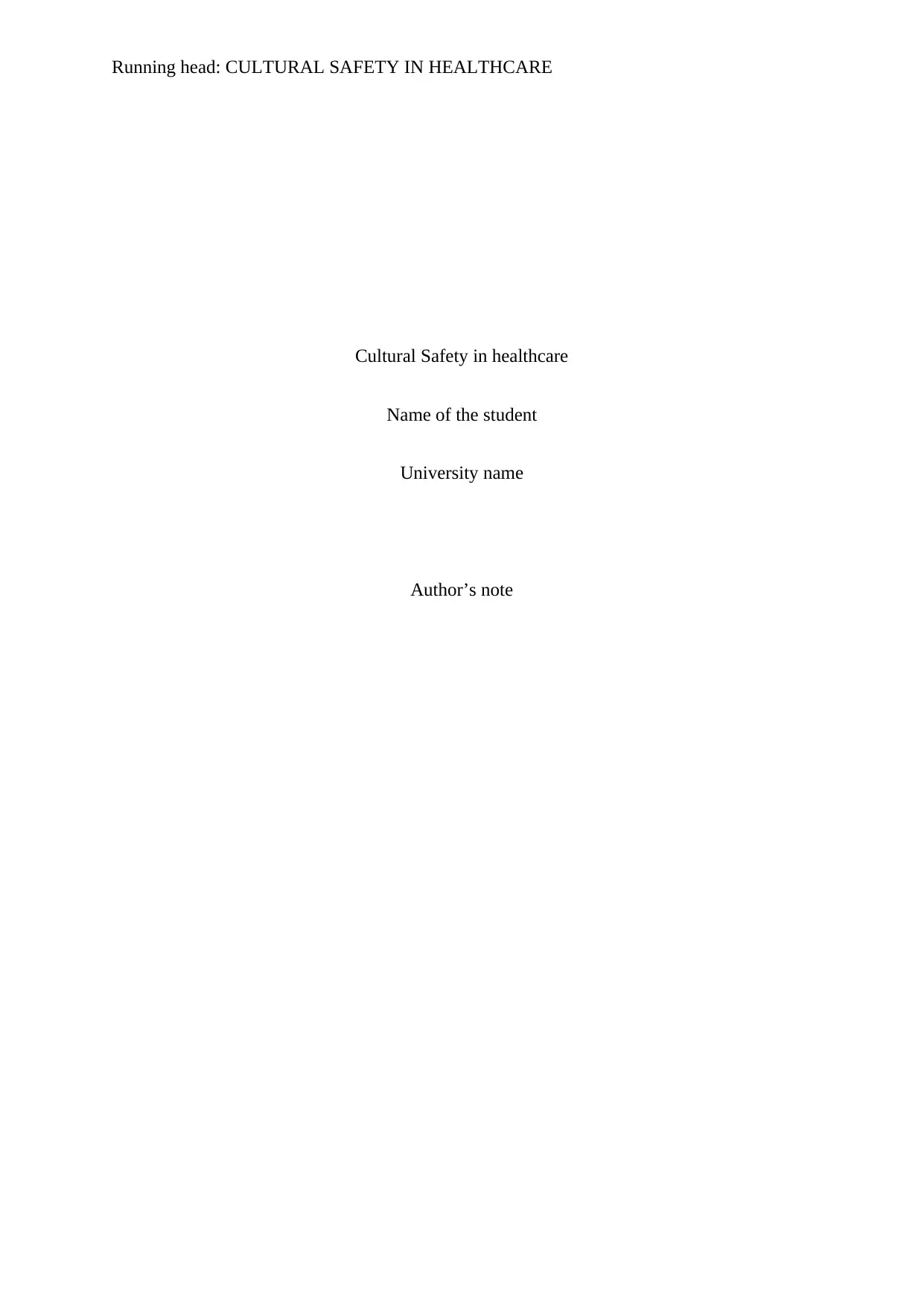
Running head: CULTURAL SAFETY IN HEALTHCARE
Cultural Safety in healthcare
Name of the student
University name
Author’s note
Cultural Safety in healthcare
Name of the student
University name
Author’s note
Paraphrase This Document
Need a fresh take? Get an instant paraphrase of this document with our AI Paraphraser
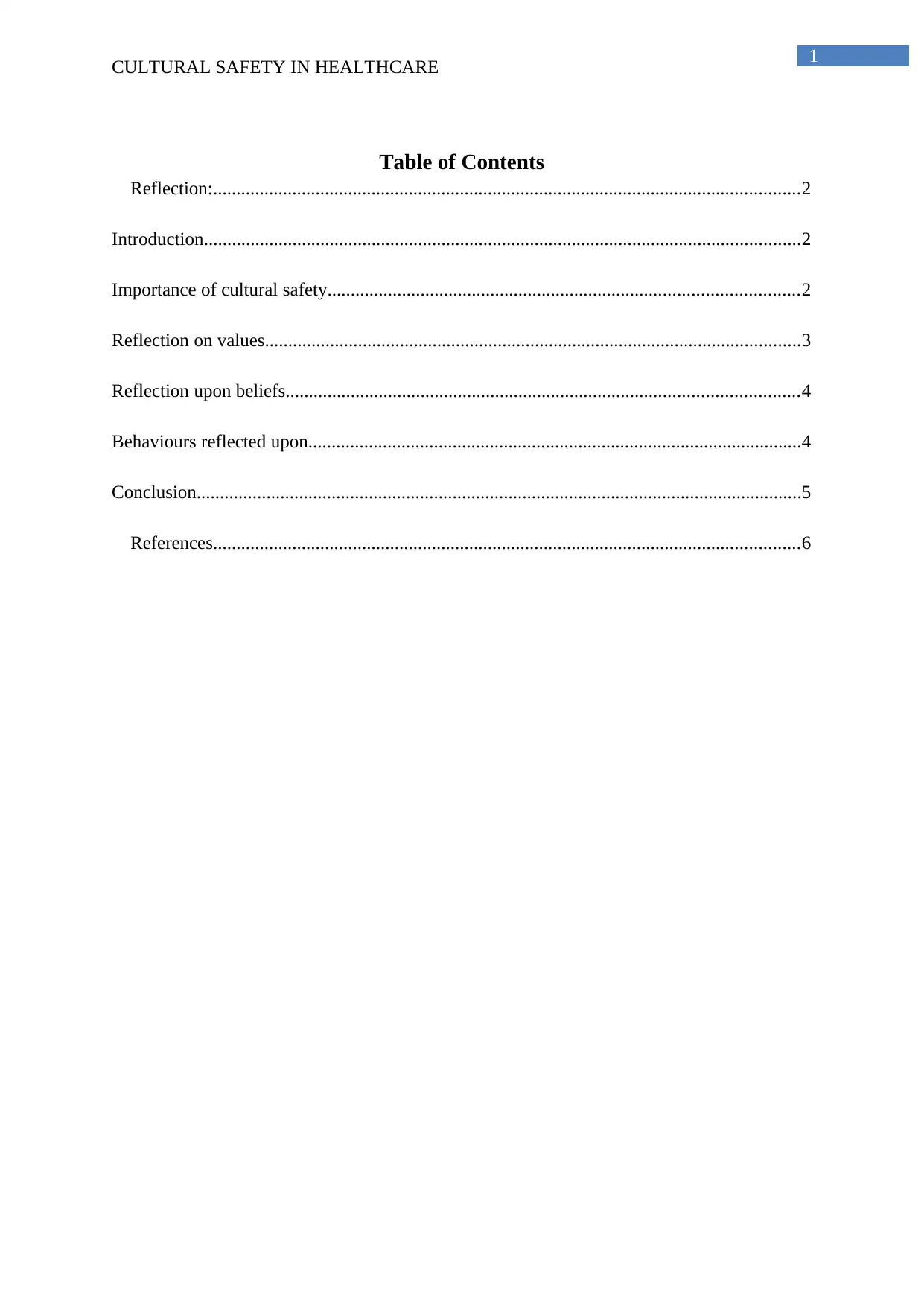
1
CULTURAL SAFETY IN HEALTHCARE
Table of Contents
Reflection:..............................................................................................................................2
Introduction................................................................................................................................2
Importance of cultural safety.....................................................................................................2
Reflection on values...................................................................................................................3
Reflection upon beliefs..............................................................................................................4
Behaviours reflected upon..........................................................................................................4
Conclusion..................................................................................................................................5
References..............................................................................................................................6
CULTURAL SAFETY IN HEALTHCARE
Table of Contents
Reflection:..............................................................................................................................2
Introduction................................................................................................................................2
Importance of cultural safety.....................................................................................................2
Reflection on values...................................................................................................................3
Reflection upon beliefs..............................................................................................................4
Behaviours reflected upon..........................................................................................................4
Conclusion..................................................................................................................................5
References..............................................................................................................................6
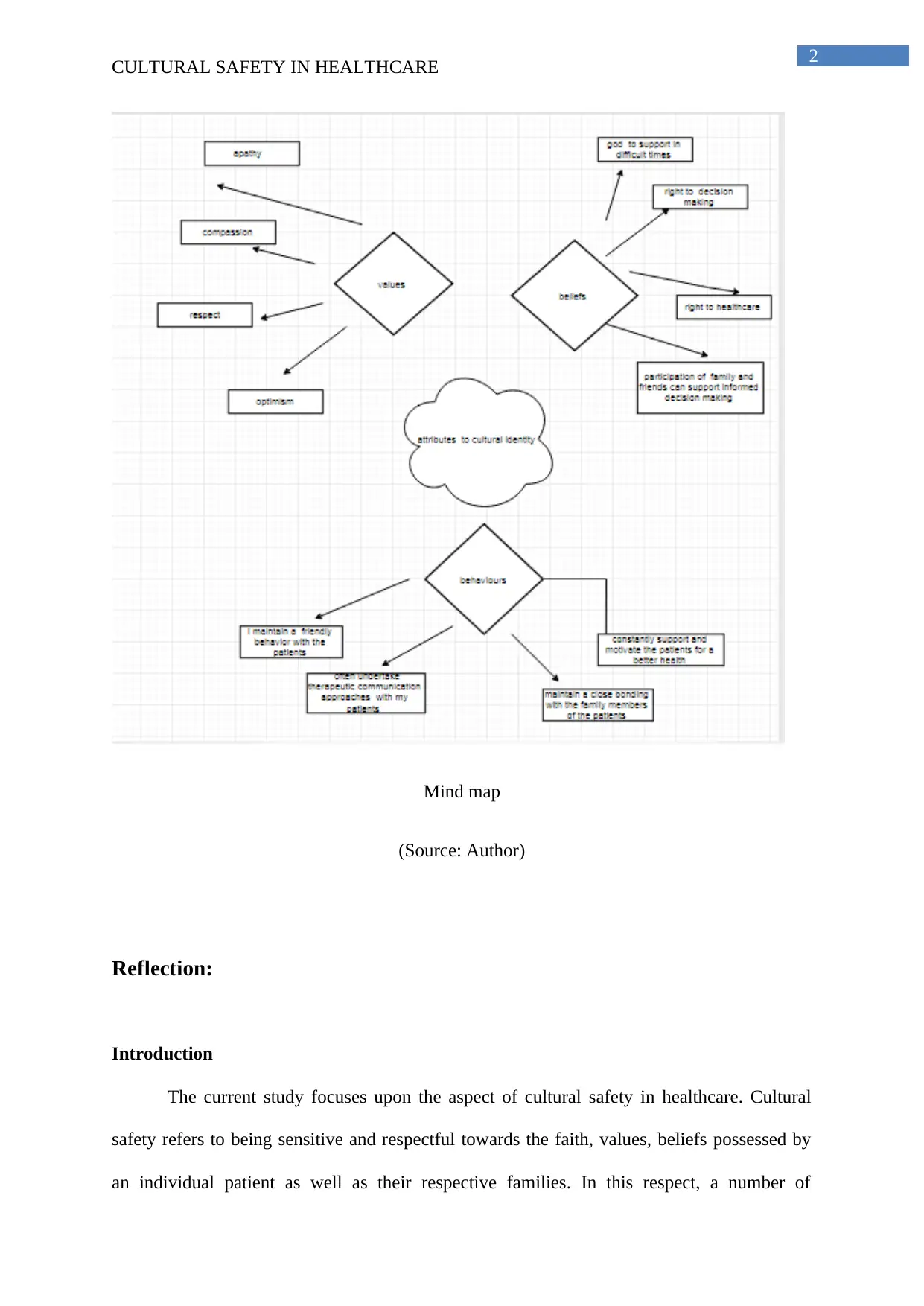
2
CULTURAL SAFETY IN HEALTHCARE
Mind map
(Source: Author)
Reflection:
Introduction
The current study focuses upon the aspect of cultural safety in healthcare. Cultural
safety refers to being sensitive and respectful towards the faith, values, beliefs possessed by
an individual patient as well as their respective families. In this respect, a number of
CULTURAL SAFETY IN HEALTHCARE
Mind map
(Source: Author)
Reflection:
Introduction
The current study focuses upon the aspect of cultural safety in healthcare. Cultural
safety refers to being sensitive and respectful towards the faith, values, beliefs possessed by
an individual patient as well as their respective families. In this respect, a number of
⊘ This is a preview!⊘
Do you want full access?
Subscribe today to unlock all pages.

Trusted by 1+ million students worldwide
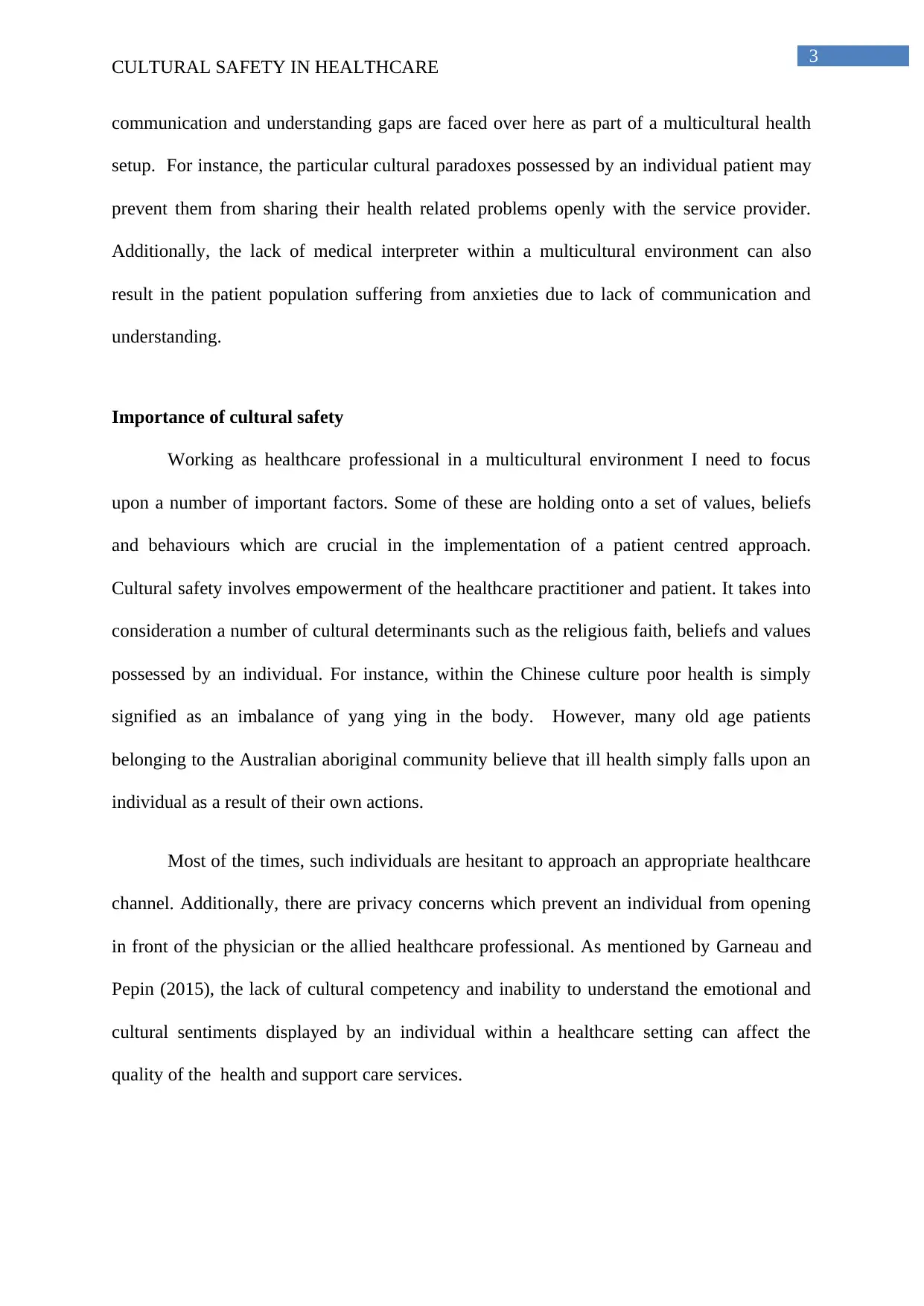
3
CULTURAL SAFETY IN HEALTHCARE
communication and understanding gaps are faced over here as part of a multicultural health
setup. For instance, the particular cultural paradoxes possessed by an individual patient may
prevent them from sharing their health related problems openly with the service provider.
Additionally, the lack of medical interpreter within a multicultural environment can also
result in the patient population suffering from anxieties due to lack of communication and
understanding.
Importance of cultural safety
Working as healthcare professional in a multicultural environment I need to focus
upon a number of important factors. Some of these are holding onto a set of values, beliefs
and behaviours which are crucial in the implementation of a patient centred approach.
Cultural safety involves empowerment of the healthcare practitioner and patient. It takes into
consideration a number of cultural determinants such as the religious faith, beliefs and values
possessed by an individual. For instance, within the Chinese culture poor health is simply
signified as an imbalance of yang ying in the body. However, many old age patients
belonging to the Australian aboriginal community believe that ill health simply falls upon an
individual as a result of their own actions.
Most of the times, such individuals are hesitant to approach an appropriate healthcare
channel. Additionally, there are privacy concerns which prevent an individual from opening
in front of the physician or the allied healthcare professional. As mentioned by Garneau and
Pepin (2015), the lack of cultural competency and inability to understand the emotional and
cultural sentiments displayed by an individual within a healthcare setting can affect the
quality of the health and support care services.
CULTURAL SAFETY IN HEALTHCARE
communication and understanding gaps are faced over here as part of a multicultural health
setup. For instance, the particular cultural paradoxes possessed by an individual patient may
prevent them from sharing their health related problems openly with the service provider.
Additionally, the lack of medical interpreter within a multicultural environment can also
result in the patient population suffering from anxieties due to lack of communication and
understanding.
Importance of cultural safety
Working as healthcare professional in a multicultural environment I need to focus
upon a number of important factors. Some of these are holding onto a set of values, beliefs
and behaviours which are crucial in the implementation of a patient centred approach.
Cultural safety involves empowerment of the healthcare practitioner and patient. It takes into
consideration a number of cultural determinants such as the religious faith, beliefs and values
possessed by an individual. For instance, within the Chinese culture poor health is simply
signified as an imbalance of yang ying in the body. However, many old age patients
belonging to the Australian aboriginal community believe that ill health simply falls upon an
individual as a result of their own actions.
Most of the times, such individuals are hesitant to approach an appropriate healthcare
channel. Additionally, there are privacy concerns which prevent an individual from opening
in front of the physician or the allied healthcare professional. As mentioned by Garneau and
Pepin (2015), the lack of cultural competency and inability to understand the emotional and
cultural sentiments displayed by an individual within a healthcare setting can affect the
quality of the health and support care services.
Paraphrase This Document
Need a fresh take? Get an instant paraphrase of this document with our AI Paraphraser

4
CULTURAL SAFETY IN HEALTHCARE
Reflection on values
In this respect, the values possessed by a healthcare professional within a
multicultural setup can help them in communicating and understanding the patient dilemmas
better. From my personal experiences of working with patients in a multicultural environment
I have realised that being compassionate and respectful towards the physical and emotional
health requirements of the patient can help in improving the recovery rate. I think the
implementation of some of the aspects within healthcare practice such as apathy can help in
reducing the mental and emotional dilemmas of the patient. As mentioned by Wepa (2015),
aspects such as therapeutic communication can promote a culture of optimism within the
healthcare environment. In my opinion, holding certain amount of respect for the patients can
also help in enhancing the standards of the care services by providing the patient population
sufficient autonomy. The positive values implemented by a healthcare professional help in
the promotion of objectives such as informed decision making. I have felt greater
trustworthiness within the patient population by implementing compassionate care
approaches. One of the most important aspects of providing culturally sensitive care is by
reducing the amount of stress within the healthcare environment. As mentioned by
Barbaranelli, Petitta and Probst (2015), stress has seen to create a negative impact upon the
health of people as well as it has been associated with factors such as compassionate fatigue.
Therefore, promoting an overall positive environment by focusing less on the stress factors
and communicating effectively with the rest of the team members have helped me in
reducing the service gaps.
Reflection upon beliefs
The faith and beliefs possessed by an individual can influence their way of practice
within a healthcare setup. As mentioned by Betancourt, Corbett and Bondaryk (2014), the
CULTURAL SAFETY IN HEALTHCARE
Reflection on values
In this respect, the values possessed by a healthcare professional within a
multicultural setup can help them in communicating and understanding the patient dilemmas
better. From my personal experiences of working with patients in a multicultural environment
I have realised that being compassionate and respectful towards the physical and emotional
health requirements of the patient can help in improving the recovery rate. I think the
implementation of some of the aspects within healthcare practice such as apathy can help in
reducing the mental and emotional dilemmas of the patient. As mentioned by Wepa (2015),
aspects such as therapeutic communication can promote a culture of optimism within the
healthcare environment. In my opinion, holding certain amount of respect for the patients can
also help in enhancing the standards of the care services by providing the patient population
sufficient autonomy. The positive values implemented by a healthcare professional help in
the promotion of objectives such as informed decision making. I have felt greater
trustworthiness within the patient population by implementing compassionate care
approaches. One of the most important aspects of providing culturally sensitive care is by
reducing the amount of stress within the healthcare environment. As mentioned by
Barbaranelli, Petitta and Probst (2015), stress has seen to create a negative impact upon the
health of people as well as it has been associated with factors such as compassionate fatigue.
Therefore, promoting an overall positive environment by focusing less on the stress factors
and communicating effectively with the rest of the team members have helped me in
reducing the service gaps.
Reflection upon beliefs
The faith and beliefs possessed by an individual can influence their way of practice
within a healthcare setup. As mentioned by Betancourt, Corbett and Bondaryk (2014), the

5
CULTURAL SAFETY IN HEALTHCARE
health belief aspects are further reflected in the way of healthcare practice. I belief that each
and every patient receiving support and care services have the right to informed decision
making as well as avail the basic healthcare services at an affordable price. Some of these
beliefs were strongly inculcated within me right from the enrolment stage by my guide. I
have always felt the need to make basic healthcare services accessible to all as the right to
healthcare states that every individual has equal access to support care services. Hence, I
have always appreciated and gladly welcomed to a part of a healthcare institute which
provides free community care services to large patient population. Additionally, my spiritual
faith and beliefs has also helped me in coping up with the huge stress environment generated
within the place of work.
Behaviours reflected upon
The behavioural aspect undertaken by an individual plays an important role in
improving the quality of health and care service provided. I have often felt that maintaining a
positive and health behaviour have helped me in understanding the dilemmas and issues
faced by the patient better. In many cases I have faced scenario where the patient was not
ready to undergo a certain procedure which was vital for his recovery. However, undertaking
a friendly and therapeutic communication approaches with the patients can help in the
development of an effective bonding. I have also felt in many cases that undertaking the role
of a motivator have helped in reducing the mental anxiety and depression present within the
patient.
Conclusion
The current study focuses upon the aspect of cultural safety in healthcare. The
cultural safety takes into consideration the religious and community beliefs possessed by an
individual (Truong, Paradies & Priest, 2014). It promotes some of the basic virtues and
CULTURAL SAFETY IN HEALTHCARE
health belief aspects are further reflected in the way of healthcare practice. I belief that each
and every patient receiving support and care services have the right to informed decision
making as well as avail the basic healthcare services at an affordable price. Some of these
beliefs were strongly inculcated within me right from the enrolment stage by my guide. I
have always felt the need to make basic healthcare services accessible to all as the right to
healthcare states that every individual has equal access to support care services. Hence, I
have always appreciated and gladly welcomed to a part of a healthcare institute which
provides free community care services to large patient population. Additionally, my spiritual
faith and beliefs has also helped me in coping up with the huge stress environment generated
within the place of work.
Behaviours reflected upon
The behavioural aspect undertaken by an individual plays an important role in
improving the quality of health and care service provided. I have often felt that maintaining a
positive and health behaviour have helped me in understanding the dilemmas and issues
faced by the patient better. In many cases I have faced scenario where the patient was not
ready to undergo a certain procedure which was vital for his recovery. However, undertaking
a friendly and therapeutic communication approaches with the patients can help in the
development of an effective bonding. I have also felt in many cases that undertaking the role
of a motivator have helped in reducing the mental anxiety and depression present within the
patient.
Conclusion
The current study focuses upon the aspect of cultural safety in healthcare. The
cultural safety takes into consideration the religious and community beliefs possessed by an
individual (Truong, Paradies & Priest, 2014). It promotes some of the basic virtues and
⊘ This is a preview!⊘
Do you want full access?
Subscribe today to unlock all pages.

Trusted by 1+ million students worldwide
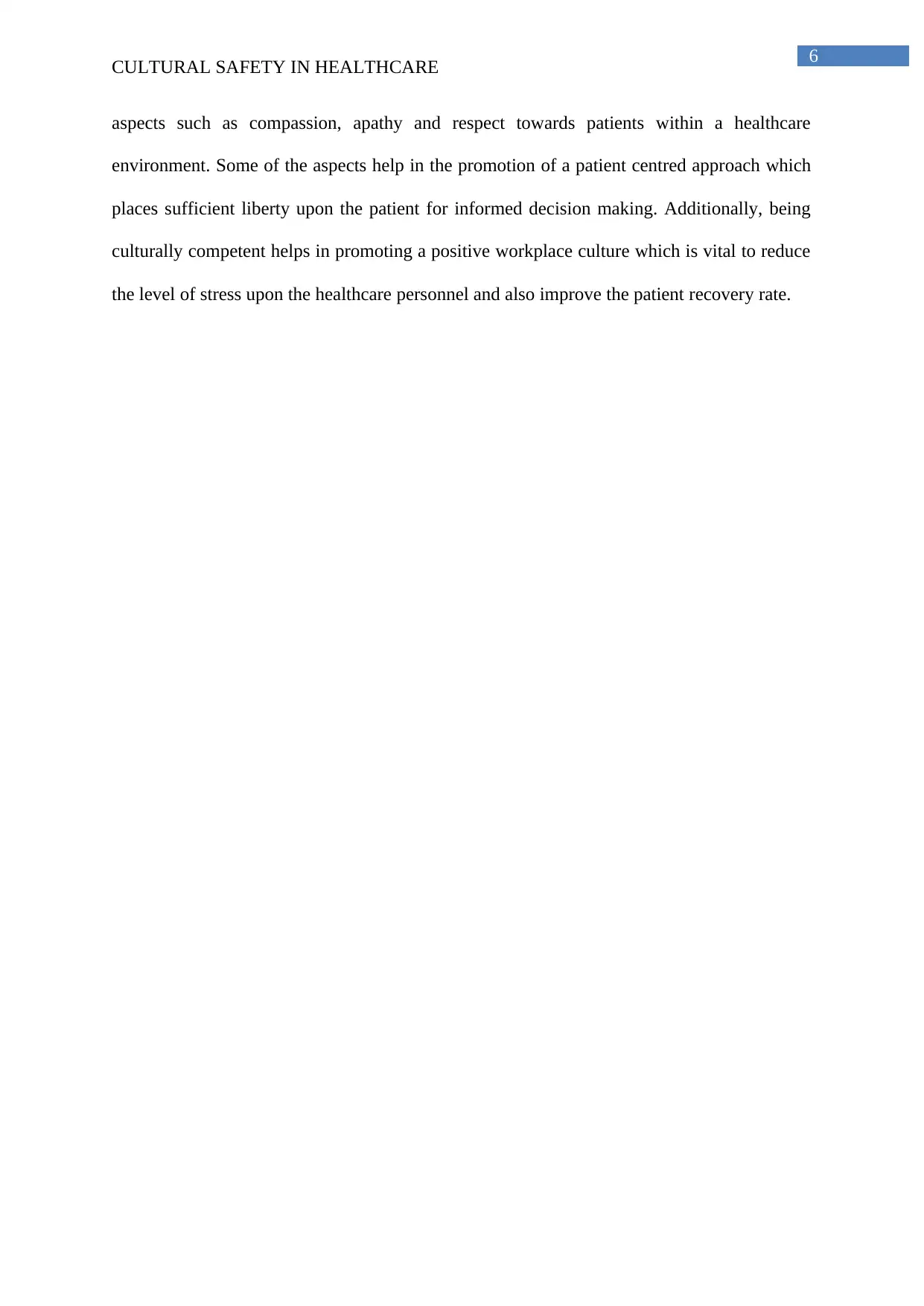
6
CULTURAL SAFETY IN HEALTHCARE
aspects such as compassion, apathy and respect towards patients within a healthcare
environment. Some of the aspects help in the promotion of a patient centred approach which
places sufficient liberty upon the patient for informed decision making. Additionally, being
culturally competent helps in promoting a positive workplace culture which is vital to reduce
the level of stress upon the healthcare personnel and also improve the patient recovery rate.
CULTURAL SAFETY IN HEALTHCARE
aspects such as compassion, apathy and respect towards patients within a healthcare
environment. Some of the aspects help in the promotion of a patient centred approach which
places sufficient liberty upon the patient for informed decision making. Additionally, being
culturally competent helps in promoting a positive workplace culture which is vital to reduce
the level of stress upon the healthcare personnel and also improve the patient recovery rate.
Paraphrase This Document
Need a fresh take? Get an instant paraphrase of this document with our AI Paraphraser
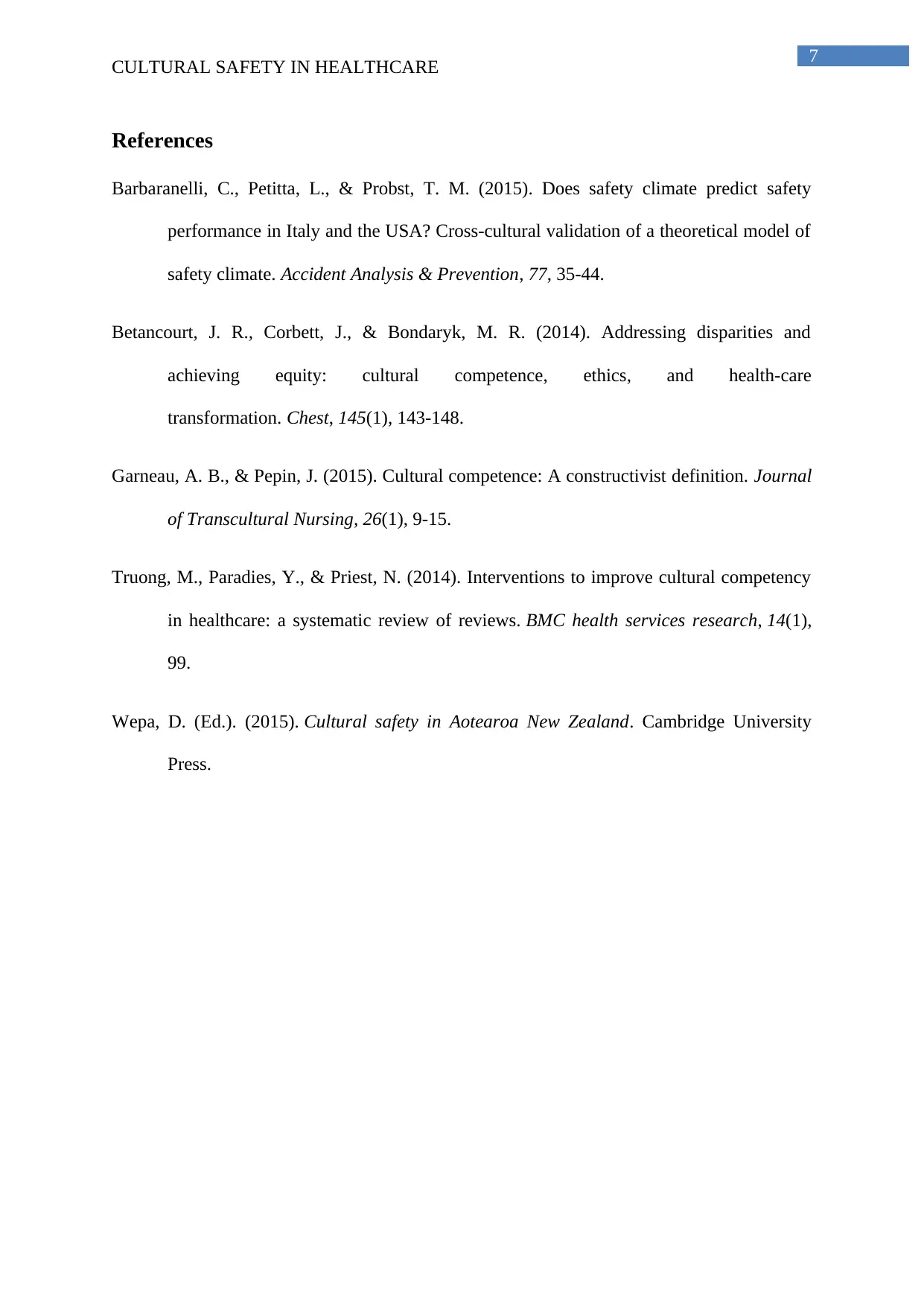
7
CULTURAL SAFETY IN HEALTHCARE
References
Barbaranelli, C., Petitta, L., & Probst, T. M. (2015). Does safety climate predict safety
performance in Italy and the USA? Cross-cultural validation of a theoretical model of
safety climate. Accident Analysis & Prevention, 77, 35-44.
Betancourt, J. R., Corbett, J., & Bondaryk, M. R. (2014). Addressing disparities and
achieving equity: cultural competence, ethics, and health-care
transformation. Chest, 145(1), 143-148.
Garneau, A. B., & Pepin, J. (2015). Cultural competence: A constructivist definition. Journal
of Transcultural Nursing, 26(1), 9-15.
Truong, M., Paradies, Y., & Priest, N. (2014). Interventions to improve cultural competency
in healthcare: a systematic review of reviews. BMC health services research, 14(1),
99.
Wepa, D. (Ed.). (2015). Cultural safety in Aotearoa New Zealand. Cambridge University
Press.
CULTURAL SAFETY IN HEALTHCARE
References
Barbaranelli, C., Petitta, L., & Probst, T. M. (2015). Does safety climate predict safety
performance in Italy and the USA? Cross-cultural validation of a theoretical model of
safety climate. Accident Analysis & Prevention, 77, 35-44.
Betancourt, J. R., Corbett, J., & Bondaryk, M. R. (2014). Addressing disparities and
achieving equity: cultural competence, ethics, and health-care
transformation. Chest, 145(1), 143-148.
Garneau, A. B., & Pepin, J. (2015). Cultural competence: A constructivist definition. Journal
of Transcultural Nursing, 26(1), 9-15.
Truong, M., Paradies, Y., & Priest, N. (2014). Interventions to improve cultural competency
in healthcare: a systematic review of reviews. BMC health services research, 14(1),
99.
Wepa, D. (Ed.). (2015). Cultural safety in Aotearoa New Zealand. Cambridge University
Press.
1 out of 8
Related Documents
Your All-in-One AI-Powered Toolkit for Academic Success.
+13062052269
info@desklib.com
Available 24*7 on WhatsApp / Email
![[object Object]](/_next/static/media/star-bottom.7253800d.svg)
Unlock your academic potential
Copyright © 2020–2025 A2Z Services. All Rights Reserved. Developed and managed by ZUCOL.





